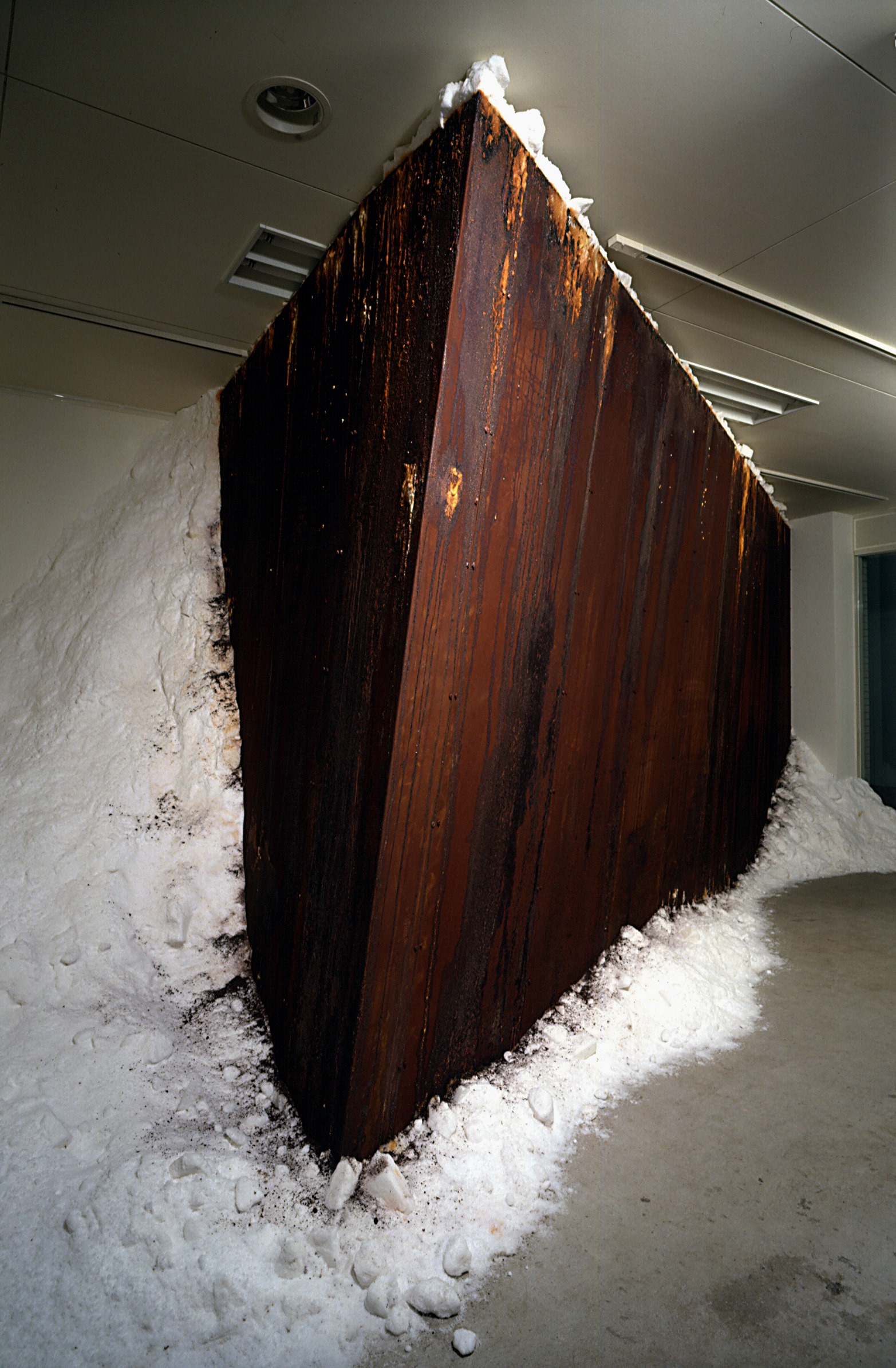タイトル:麹町画廊Open:vol1Garage/White Cube 「麹町画廊のあいまいな部分」 山本基展「ウツロナルモノ」https://test.artto.jp/?post_type=archive&p=535&preview=true
時期:2000年5月12日(金)〜5月28日(日)
場所:麹町画廊
アーティスト:山本基
主催:麹町画廊
Kojimachi Gallery Open:Vol.1
Garage / White Cube “Ambivalence of Kojimachi gallery space’’
Motoi Yamamoto Exhibition -Unfulfilled-
2000.5.12 FRI – 5.28 SUN
Venue : Kojimachi Gallery
Artist : Motoi Yamamoto
Sponsor : Kojimachi Gallery
知りえない部分へ、近づいて。
「言語の可能性、自由…の中で渦巻いている一つ目の死がある。そしてそれが二重になり、つかむことのできない死がある。それは、私が捕らえられないもの、いかなる方法のいかなる関係をもっても、私に結び付けられることのないもの。それは、決して私に帰着することのないものであり、それに向けて私は自身とどうすることもできない。」
(M・ブランショ 文学空間)
「記憶への回廊」、「めいそうの大陸」という作品で、山本基が表するものは、死という概念が明かす、知ることのできない領域と見ることができるかもしれない。
これらのサイト-スペシフィックな作品は、幾層にも積み重ねられた壮大な塩のブロックと、錆びた鉄板から成り立ち、大きさと重量感において見る人を圧倒する。作品の内部や奥行きは、外側を覆っている鉄板で直接窺い知ることはできない。唯一覗き見ることができるのは、鉄板の切れ目から現れ出る塩で固められた狭い路だ。大人には狭すぎるその路は、先にある暗闇に引き込まれるにつれ、確かな身体反応を生じさせる可能性を湛えている。暗がりは今日の日常的な時間や空間の流れに亀裂を生じさせ、認識することはできないが、私たちの身体が必然的に反応してしまう感覚を表現している。中に何があるのか、また何が起こっているのかを知りたいという思いが高まる。しかし、それはできない。見る者は、奥に未知の空間があるということを認めつつも、実際に知覚することのないまま、その外側に留まらなければならない運命にあるのだ。「ほら、そこにある。しかしほとんど辿り着くことはできない。」と。
これは、身体全体に行き渡る死の過程と大いに関係あることだろう。死に向かい合い、人はそれに自覚を持って近づいてゆく。しかし、ある時点から論理的な思考能力を奪われる。その朽ちゆく存在は、理路整然たる言葉による説明のうちに、「死ぬ」ということを認識できず、自分の最後をしっかりと知覚することができない。山本の作品の暗がりは、この理解し得ない部分と呼応するといえるだろう。それは、「知る」ということについて、興味と不安を同時に引き起こす。しかしながら、それに立ち向かう者は次の事実を引きうけなければならない。見るものは先に進めば進むほど、闇がより重くのしかかってくるということだ。その中で、彼は知識(知ること)の意味の無さと理解不能な情動を余儀なくされ、言葉を介さない彼自身の内なるコミュニケーションにさらされる。闇というイメージの不在は、「知る」という通常の感覚が解体される領域だ。
このテーマを実現するため、山本は、心と身体を清める意味に注目して、塩を制作の材料として使っている。またそれだけでなく、彼は、塩を、例えば「食卓塩」や「減塩みそ汁」などの表示に見られる、もとからある「自然」を生産的な目的において対象化したものとしてではなく、むしろこの世のすべての存在にとって必要不可欠な物質である「塩」そのものとして提示する。このように作り上げられる作品は、すべての生と死を包含するような、印象深く、また力強いイメージを現出させているのだ。
死に関するこのような見方は、今日のそれの一般的な見方に対抗するものと見ることができるだろう。山本は作品で、死を概念化する社会の傾向を明るみに出すと共に、再考し、そしてそれに疑問を投げかける。20世紀を通して進化した社会において、死の概念は社会福祉のシステム、医学などの高度なレベルの介入を通して社会の言説に裁断されるものとなっており、その身体が担う実際の過程からは遠ざけられている。例えば脳死という概念は、死の判断基準の恣意性をつまびらかにし、大きな議論を巻き起こしている。それは、取りも直さず臓器移植のための「生ける死」の創造であり、そこにおいて人間の死というものは、人体の全体的な破滅の前に、脳の全機能停止によって引き起こされる人格の剥奪をもって宣告される。このような社会的文脈の中で、山本は、一方で「死とは一体何であるのか」ということを問いつづけ、また一方で、こうした死の現実性をぼやけさせる支配的な社会の傾向に否を唱える。
結論として、山本基の作品は、認識不可能と思われるもの、あるいは、死はいつもすぐそこにありつづけているという事実にも拘わらず、社会によって覆い隠され、無視されてきたものを私たちに気づかせる「装置」ということができるだろう。暗がりの中のイメージの不在は、私たちの日常生活を超越したところにある「知りえないもの」の感覚を引き起こす裂け目である。そこから、私たちは塩の路を通り、いまだに明かされることのない、死が開く領域へと導かれることになるのであろう。
小澤慶介
Approaching The Unknowable
“There is one death which circulates in the language of possibility, of liberty…; and there is its double, which is ungraspable. It is what I cannot grasp, what is not linked to me by any relation of any sort. It is that which never comes and toward which I do not direct myself.”
(M.Blanchot, The Space of Literature)
With the art works entitled “a corridor of remembrance” or “land of meditation”, what Motoi Yamamoto represents could be described as an unknowable realm in which the notion of death unfolds.
These site-specific works, consisting of a massive quantity of bricks made of salt, piled up in layers together with rusty irons slabs, overwhelm the viewers in side and volume.
Concealed by the slabs, one is not able to see the interior and depth of the edifice but a narrow path emerges from between the slabs. The path, which is too narrow for adults to go in to, gives a sense of a potency that demands a distinct physical response, as it leads to total darkness. It gives an interstice in the flux of time and space of everydayness in the present day, and embodies a sense of unconceivable and yet our physical instinct can respond to it.
One might feel like going in to know what exists or happens in there; however one is destined to remain on the outside leaving it as an unknown space despite recognizing its existence. “There, there is, yet quite attainable.”
It could be said that this has much to do with the understanding of holistic death. In that, one can approach to death in awareness; however, from a certain point, one is deprived of an ability of discursive thinking. Therefore the annihilated being cannot grasp its own end. It cannot be conceived within a definitive point of coherent discourse. The darkness of the work simultaneously evokes interest and anxiety to know more. However, the onlooker has to bear the fact that the further he goes in the heavier the darkness becomes. In that
he is exposed to inability of knowledge but an inner communication without discourse reduced to an unintelligible emotion. It is not too much to say that the void of image in the work represents the realm in which usual sense of knowing is dismantled.
To realize his theme, Yamamoto employs salt as a material focusing on of its properties, as purifying the body and soul. Furthermore, he presents it not as the object of the natural in the productive end as in the notions like “table salt” or “lightly salted crisps” but rather an indispensable material for every single being beyond time and space. Thus, the work appears to render a distinctive, effective, powerful image to encompass life and death in its whole entity.
Such a perception of death could be seen as a counter towards its common understanding in the present day. With the works, Yamamoto calls it into question and attempts to unveil as well as reconsider the social tendency that idealize the notion of death. In the society that has evolved throughout the 20th century, it is deemed that death has become the object sanctioned by public discourse, through the high level of intervention by social welfare systems, medical science etc., and estranged from its actual process. For instance, the concept of brain death creates a great controversy because it reveals the arbitrariness of the criteria for the decision of death. It is a creation of a living dead for demand of organ transplants, and human death is acclaimed with the deprivation of personality caused by the cessation of the entire function of the brain, before the holistic destruction of the human body. In such a social context, Yamamoto is concerned with the dominant social inclination, which might blur the reality of death and put people off from considering “what death is all about”.
Yamamoto’s works give a sense of a device that enables the viewers to be aware of what is thought to be unconceivable or what has been concealed and neglected by the society despite the fact that death has always been there. The void of an image in the darkness is a crack which induces the feeling of the unknowable beyond our everyday life. In that, one might be led to a sacred sphere through the path of salt.
Kai Ozawa

